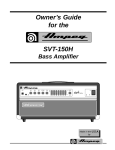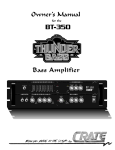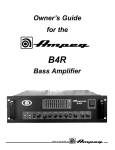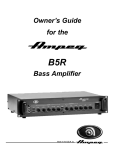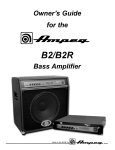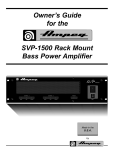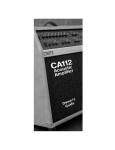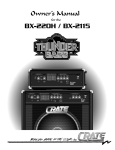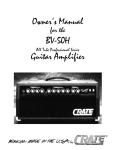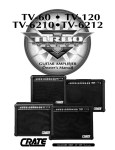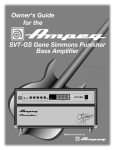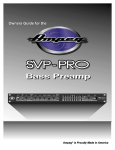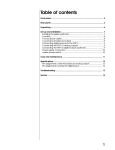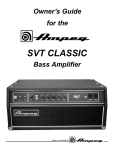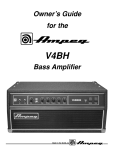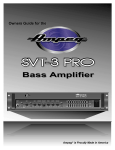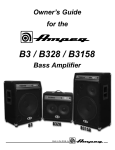Download Ampeg Svt-Cl Musical Instrument User Manual
Transcript
Owner’s Guide for the SVT-CL Bass Amplifier 1 2 3 4 5 0dB -15dB HI STANDBY/ POWER/ FAULT LO INPUTS GAIN ULTRA HI/LO BASS MIDRANGE FREQUENCY TREBLE MASTER STANDBY POWER SVT-CL Table of Contents Important Safeguards and Precautions . . . . . . . . . . . . . .2 Introduction . . . . . . . . . . . . . . . . . . . . . . . . . . . . . . . . . . .3 Features . . . . . . . . . . . . . . . . . . . . . . . . . . . . . . . . . . . . .3 System Block Diagram . . . . . . . . . . . . . . . . . . . . . . . . . .3 The Front Panel Controls and Their Use . . . . . . . . . . . . .4 The Rear Panel Controls and Their Use . . . . . . . . . . . . .5 Some Suggested Settings . . . . . . . . . . . . . . . . . . . . . . . .6 Changing the Tubes . . . . . . . . . . . . . . . . . . . . . . . . . . . .7 Troubleshooting . . . . . . . . . . . . . . . . . . . . . . . .back cover Technical Specifications . . . . . . . . . . . . . . . . . .back cover Important Safeguards and Precautions All Ampeg products are designed for continuous safe operation, as long as common sense is used and steps are taken to help avoid certain problems. Abiding by the following rules can help prevent damage to your amplifier, yourself and others. • The amp is equipped with a three-prong AC power cord. To reduce the risk of electrical shock, NEVER remove or otherwise attempt to defeat the ground pin of the power cord. • Connect the amp ONLY to a properly grounded AC outlet of the proper voltage for your amp. If no grounded outlet is available, use only an approved method of adapting to a two-prong AC source. • Avoid sudden temperature extremes, rain and moisture. Also, avoid sudden and intense impact. (If the unit has been subjected to any of the preceding abuses, have it looked at by an authorized service center.) • NEVER set the amp on a support that might give out under its weight. • Always keep the total impedance at or above the rated load. • Unplug the amp before cleaning it. NEVER spray liquid cleaners onto the unit. Wipe the unit with a slightly dampened, lint-free cloth to remove dirt and film. • Don’t use the amp if it has sustained damage to the chassis, controls, or power cord. Refer the unit to an authorized service center for inspection. • Amplifiers capable of producing high volume levels are also capable of inflicting permanent hearing loss or damage, if the exposure to such levels is prolonged. Such damage is progressive and irreversible! Caution is advised and ear protection recommended when playing at extremely loud levels. The chart below shows the U.S. Government Occupational Safety and Health Administration (OSHA) regulations which were in effect at the time of this publication for permissible noise exposure, per 29CRF1910, Table G-16. SOUND LEVEL dBA SLOW RESPONSE DURATION PER DAY IN HOURS SOUND LEVEL dBA SLOW RESPONSE DURATION PER DAY IN HOURS 90 92 95 97 100 8 6 4 3 2 102 105 110 115 1-1/2 1 1/2 1/4 or less According to OSHA, any exposure in excess of those listed above could result in some hearing loss. CAUTION ATTENTION VORSICHT RISK OF ELECTRIC SHOCK DO NOT OPEN RISQUE D'ELECTROCUTION NE PAS OUVRIR ELEKTRISCHE SCHLAGGEFAHR NICHT OFFENEN CAUTION: TO REDUCE THE RISK OF ELECTRIC SHOCK, DO NOT REMOVE COVER. NO USER-SERVICEABLE PARTS INSIDE. REFER SERVICING TO QUALIFIED SERVICE PERSONNEL. ATTENTION: POUR REDUIRE D'ELECTROCUTION NE PAS ENLEVER LE COUVERCLE. AUCUNE PIECE INTERNE N'EST REPRABLE PAR L'UTILISATEUR. POUR TOUTE REPARATION, S'ADRESSER A UN TECHNICIEN QUALIFIE. VORSICHT: ZUR MINIMIERUNG ELEKTRISCHER SCHLAGGEFAHR NICHT DEN DECKEL ABENHMEN. INTERNE TEILE KONNEN NICHT VOM BENUTZER GEWARTET WERDEN. DIE WARTUNG IS QUALIFIZIERTEM WARTUNGSPERSONAL ZU UBERLASSEN. THIS EQUIPMENT HAS BEEN DESIGNED AND ENGINEERED TO PROVIDE SAFE AND RELIABLE OPERATION. IN ORDER TO PROLONG THE LIFE OF THE UNIT AND PREVENT ACCIDENTAL DAMAGES OR INJURY, PLEASE FOLLOW THESE PRECAUTIONARY GUIDELINES: CAUTION: TO REDUCE THE RISK OF ELECTRIC SHOCK, DO NOT OPEN CHASSIS; DO NOT DEFEAT OR REMOVE THE GROUND PIN OF THE POWER CORD; CONNECT ONLY TO A PROPERLY GROUNDED AC POWER OUTLET. WARNING: TO REDUCE THE RISK OF FIRE OR ELECTRIC SHOCK, DO NOT EXPOSE THIS EQUIPMENT TO RAIN OR MOISTURE. CAUTION: NO USER-SERVICEABLE PARTS INSIDE. REFER SERVICING TO QUALIFIED SERVICE PERSONNEL. CAUTION: OUR AMPLIFIERS ARE CAPABLE OF PRODUCING HIGH SOUND PRESSURE LEVELS. CONTINUED EXPOSURE TO HIGH SOUND PRESSURE LEVELS CAN CAUSE PERMANENT HEARING IMPAIRMENT OR LOSS. USER CAUTION IS ADVISED AND EAR PROTECTION IS RECOMMENDED IF UNIT IS OPERATED AT HIGH VOLUME. 2 EXPLANATION OF GRAPHICAL SYMBOLS: "DANGEROUS VOLTAGE" = "DANGER HAUTE TENSION" "GEFAHLICHE SPANNUNG" "IT IS NECESSARY FOR THE USER TO REFER TO THE INSTRUCTION MANUAL" = "REFERREZ-VOUS AU MANUAL D'UTILISATION" "UNBEDINGT IN DER BEDIENUNGSANLEITUNG NACHSCHLAGEN" SVT-CL An Introduction to your new Ampeg SVT-CL Bass Amplifier The harmonically rich sound and legendary performance of the classic AMPEG SVT are redefined in the SVT-CL. This dynamically powerful bass amp delivers a thunderous 300 watts of unsurpassed quality, reliability and tonal flexibility, offering the classic vibrance of tubes as well as contemporary features. All of the features and controls of your SVT-CL are covered in detail within the pages of this owner’s guide. We recommend going over them before you use the amplifier. Features In the world of high performance bass amps, SVT amplifiers stand alone. In true Ampeg tradition, the SVT-CL offers you more power, performance and flexibility than any other amplifier in its class. Listed below are some of the outstanding features of your new amp: features which set it apart from the competition! Additional information on these features can be found on the pages indicated. • -15dB INPUT: This feature is perfect for “active” basses (page 4). • ULTRA LO AND ULTRA HI SWITCHES: These enable you to tailor your sound in many different ways at the touch of a button (page 4). • 5-POSITION FREQUENCY SELECTOR: Take your pick from the five center frequency points to get just the right midrange voice (page 4). • BIAS ADJUSTMENT CONTROLS: These controls allow you to adjust the tube bias for proper operation (pages 5 & 7). • SLAVE OUT: Use for powering another amp from the SVT-CL’s preamp (page 5). System Block Diagram PWR AMP INPUT BAL OUT SLAVE OUT IMPEDANCE 4 OHMS 2 OHMS POWER AMP 1/4" JACK PREAMP OUT 0dB INPUT BIAS ADJUST BUFFER 1/4" JACK MASTER GAIN BASS TREBLE -15dB INPUT ULTRA HI ULTRA LO SPEAKER OUTS POWER AMP PROTECTION MID 1+ 1- FREQUENCY 2+ POWER STANDBY FAULT ® 2- SPEAKON JACK BIAS INDICATORS 3 SVT-CL The Front Panel Controls and Their Use 1 2 3 4 5 0dB -15dB HI STANDBY/ POWER/ FAULT LO INPUTS GAIN ULTRA HI/LO BASS MIDRANGE FREQUENCY TREBLE MASTER STANDBY 1 2 3 4 5 1. 0dB INPUT: This jack accepts the signal from a passive instrument through a shielded instrument cable. 2. -15dB INPUT: This jack accepts the signal from an active instrument through a shielded instrument cable. 3. GAIN: This control adjusts the basic level of signal in the preamp. 4. ULTRA HI: This switch boosts high frequencies. 5. ULTRA LO: This switch, when engaged, provides emphasis to the low frequencies by boosting the low frequencies and selectively cutting the mid frequencies. 6. BASS: This is the primary low frequency control. It allows for 12dB of cut or boost at 40Hz. 7. MIDRANGE: This is the primary midrange control. It allows for 20dB of cut or 10dB of boost at the center frequency selected by the Frequency control (8). 4 6 7 8 9 10 8. FREQUENCY: Allows you to select the center frequency for the Midrange control (7), giving you a choice of five “voices” for the Midrange. The center frequencies are (from left to right) 220Hz, 450Hz, 800Hz, 1.6kHz and 3kHz. 9. TREBLE: This is the primary high frequency control. It allows for 20dB of cut or 15dB of boost at 4kHz. 10. MASTER: This controls the signal level to the power amp and therefore the overall listening level. It also controls the level to the Preamp Out jack (20). 11. STANDBY/POWER/FAULT INDICATOR LED: This is a multifunction LED. In Standby Mode, it glows red. In the On mode (when the high voltage comes on) it glows green. If it does not turn green in the On mode, there is no high voltage present and the unit needs servicing. If the amp detects a fault in the power tube circuit, the high voltage is turned off and the LED flashes between red and green. 11 12 POWER 13 This usually indicates a bad power tube. The amp will remain in this condition until the unit is turned off. 12. STANDBY: The Standby mode allows the tubes to warm or remain warm without high voltage being applied to them. This extends tube life. This switch should be OFF when first turning the amplifier on. Allow the unit to warm up for 20 seconds before switching to the ON position. During short periods of non-use, the amp should be put into Standby mode. 13. POWER: This supplies AC power to the unit. Turn this switch on before turning on the Standby switch (#12), as explained above. This switch must be turned off to reset the amp after a Fault condition. SVT-CL The Rear Panel Controls and Their Use 14 15 16 14. AC LINE IN: Firmly plug the supplied AC power cord into this socket, pushing it in until it is fully seated. Plug the male end of the cord into a grounded AC outlet. DO NOT DEFEAT THE GROUND PRONG OF THE AC PLUG! 15. FUSE: This protects the unit from damage due to overload conditions or power line surges. If the fuse blows, replace it only with the same size and type. 16. POLARITY: Place this switch in the position that provides the least electrical buzz from the unit. 17. BIAS SECTION: These two controls and sets of LEDs allow the user to properly bias the power amp. See “Setting Tube Bias” on page 7 for a complete description of how to use this section. 18. SLAVE OUT: This jack receives the same signal that is being sent to the power amp. It is 17 18 useful for powering another amp (slave) from this unit’s preamp. 19. BALANCED OUT: This XLRtype jack is the output at the power amp in. Thus, it will include any processing done in the Preamp Out/Power Amp loop (16, 17). This signal can be used to feed an external power amplifier, mixing console or house PA system. 20. PREAMP OUT: This jack carries the post-Master (10) signal. Using this jack does not break the path to the power amp. This signal can be used to feed an external power amplifier, mixing console or house PA system. 21. POWER AMP IN: This jack accepts a signal to be sent to the power amp and the Slave Out jack (18). Using this jack breaks the path from the signal that was present at the Preamp Out jack (20). This can be used as a post-Master (10) patch point. 19 21 20 22 23 22. IMPEDANCE SELECTOR: Use this switch to match the output impedance of the amp to the speaker(s) being used (2 or 4 ohms). For help in deciding the total impedance of your system, consult the chart below. Cabinet Impedance Number of Cabinets 2 ohms 4 ohms 4 ohms 8 ohms 8 ohms 1 1 2 2 4 Total Impedance 2 4 2 4 2 ohms ohms ohms ohms ohms 23. SPEAKER OUT: Two 1/4” phone jacks and one Speakon® jack are provided for connecting speakers to the unit. These jacks are wired in parallel to each other. When operating at or near full power, the Speakon® jack is recommended for use over the 1/4” jacks due to its higher current handling capability. NOTE: In some areas 1/4” speaker jacks are not acceptable for use on amplifiers with high output power levels. For this reason the 1/4” jacks on your amplifier may not be accessable – use the Speakon® jack. 5 SVT-CL Some Suggested Settings JAZZ: 1 2 3 4 5 HI LO GAIN ULTRA HI/LO BASS MIDRANGE FREQUENCY TREBLE MASTER IN The setting of the Gain control depends on your particular instrument. FUNK: IN 1 2 3 4 5 HI LO GAIN ULTRA HI/LO BASS MIDRANGE FREQUENCY TREBLE MASTER TREBLE MASTER TREBLE MASTER IN ROCK: 1 2 3 4 5 HI LO GAIN ULTRA HI/LO BASS MIDRANGE FREQUENCY COUNTRY: 1 2 3 4 5 HI LO GAIN ULTRA HI/LO IN 6 BASS MIDRANGE FREQUENCY The Master should be set to produce the appropriate output volume level. SVT-CL Changing the Tubes Tubes wear out in direct proportion to how often and how hard you play the amplifier. Power tubes should be checked at least once a year - more frequently if you use the amplifier nearly every day. When power tubes wear out, the amplifier will begin to grow weak, lack punch, fade up and down, or lose highs and lows. Power tubes work together in a push/pull configuration and should all be replaced at the same time with matched or balanced tubes. Your dealer can recommend the best replacement tubes for your amplifier. Preamp tubes aren’t worked as hard as power tubes and typically last longer. When a preamp tube wears out, the amplifier may squeal, get noisy, lose gain and sensitivity, or just quit working. A service center can determine which tube(s) may need replacing. To get to the power tubes in the SVT-CL, the rear screen must be removed and the tube retainer(s) must be moved out of the way. Qualified service persons may follow these steps to change the tubes: • • • • • Turn the amp off, unplug it and let it cool for at least 5 minutes. Remove the screws which hold the perforated metal screen to the rear of the cabinet. Set the perforated metal screen aside. Remove the tube retainer(s) by lifting them off the tube(s) and moving them to one side. Grasp the tube at its top and gently work it out of its socket by rocking it slightly back and forth as you lift up on it. • When inserting new output tubes, align the tab in the tube’s plastic base with the slot in the socket and press the tube gently but firmly into place by pushing down on its top. • Replace the perforated metal screen and tighten its screws. • Power up the amplifier and let it sit for at least 20 minutes. Bias the amplifier as directed in the section below. Setting Tube Bias Allow the unit to warm up at proper AC line voltage for at least 20 minutes. With no input signal present, adjust each control so that only the associated green LED is lit. The controls may be slightly interactive. If neither LED is lit, the amp is over biased.This will result in some distortion in the power amp and a generally thin sound. If the green and red LED are lit, the amp is under biased and too much current is flowing to the power tubes. This will give a big, full sound but will also reduce the life of the power tubes. Once set, the controls should not have to be changed except as needed for tube replacement, or to compensate for tube aging. Note that the AC line voltage may vary from place to place and the LEDs will read slightly different. There is no need to fiddle with this every other day. Note that it is normal for the red LEDs to light when there is a signal present. Bias 1 Control adjusts the three left (as seen from the rear) power tubes. Bias 2 Control adjusts the three right power tubes. By observing the LEDs as the Bias Controls are slowly rotated clockwise, a number of tube problems can be diagnosed by the user: Condition Green comes on, then red Problem No problem Solution The longer the green LED is on before the red LED comes on – the better matched the tubes are. Red comes on, then green Tubes not properly matched Set slighty before green comes on, obtain matched tubes when possible. Red comes on, no green One or more tubes are non-functioning Check to make sure tubes are all seated properly; if so, find and replace bad tube(s). None on Possibly no high voltage or bad Bias Control or bad tube(s) Have unit checked by a service technician. Both on all the time Possible bad Bias Control or bad tubes Have unit checked by a service technician. If the tubes are bad enough to cause damage to the unit, the Fault Indicator (#11, Front Panel) will signal and the unit will shut down.








